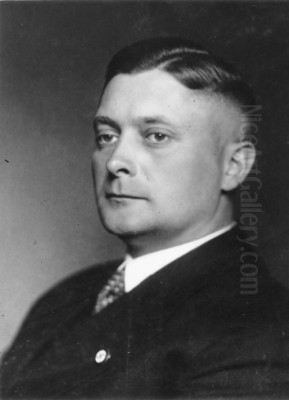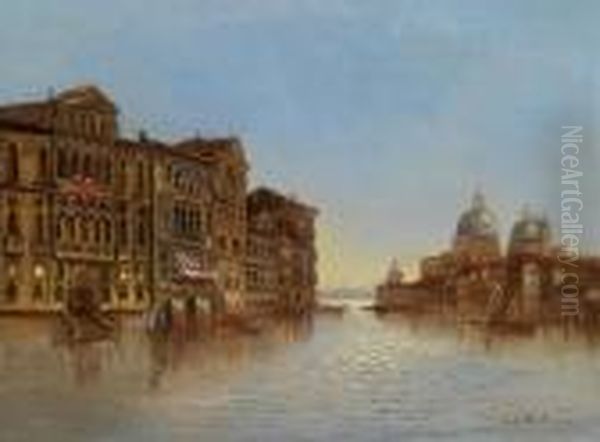
Karl Kaufmann stands as a notable figure in late 19th and early 20th-century European art. Born in 1843 and passing away in 1901, his artistic legacy is primarily built upon his evocative landscape and architectural paintings. Sources identify him as an Austrian painter, though his origins trace back to Germany, creating a blend of cultural influences in his life and work. His output reflects a deep connection to the Romantic movement, characterized by a profound appreciation for the beauty of the natural world and the grandeur of historical structures.
Kaufmann's artistic sensibilities were shaped by his environment and education. He spent his formative childhood years in Rottensee, Germany. His innate talent for drawing and painting led him to pursue formal training at the prestigious Academy of Fine Arts Munich. This period of systematic education allowed him to hone his technical skills and develop a unique artistic voice, laying the foundation for his future career.
Following the completion of his studies in Munich, Kaufmann embarked on travels across Europe. This practice was common among artists of the era, seeking inspiration beyond the confines of the academy. These journeys exposed him to diverse landscapes, architectural styles, and cultural atmospheres, significantly enriching his artistic perspective and providing a wealth of subjects for his canvases. His travels were instrumental in shaping the thematic focus of his later work.
The Venetian Inspiration
A pivotal moment in Karl Kaufmann's artistic journey occurred in 1871 when he relocated to Venice, Italy. This city, with its unique interplay of water, light, and magnificent architecture, seems to have captured his imagination profoundly. It was in Venice that Kaufmann arguably found his true artistic calling. The city became a recurring and central theme in his oeuvre, allowing him to explore his fascination with atmospheric effects and architectural detail.

His Venetian scenes are celebrated for demonstrating a sophisticated understanding of nature and a palpable reverence for historical buildings. He frequently depicted famous landmarks, immersing them in the characteristic Venetian light and atmosphere. The canals, bridges, and palazzos of Venice provided endless inspiration, enabling him to showcase his mastery in capturing the city's unique charm and romantic allure. His time in Venice was exceptionally productive and defined a significant part of his artistic identity.
Kaufmann's paintings often feature iconic Venetian locations. Works depicting the Campanile (St. Mark's Bell Tower) and the Doge's Palace highlight his ability to render complex architectural forms with precision while simultaneously evoking the historical weight and visual splendor of these structures. His dedication to capturing the essence of Venice cemented his reputation as a skilled painter of cityscapes, particularly those of the Italian lagoon city.
Signature Works and Thematic Range
Karl Kaufmann's body of work includes several well-regarded paintings that exemplify his style and thematic interests. Among his representative pieces is the Rialto Bridge in Venice. This work likely showcases his skill in depicting famous architectural landmarks within their vibrant urban context, capturing the bustling energy and unique light of the city.
Another significant work mentioned is St. Peter's Basilica in Rome. This indicates that his artistic exploration of Italy extended beyond Venice. Painting such a monumental structure would have allowed Kaufmann to demonstrate his prowess in handling perspective, scale, and the interplay of light and shadow on grand architectural surfaces, reflecting the influence of historical subjects on his Romantic sensibilities.
His Venetian portfolio is further enriched by specific views such as Scene of Venice with a View of the Santa Maria della Salute. This painting focuses on another iconic Venetian landmark, the baroque church at the entrance of the Grand Canal, celebrated for its magnificent dome and prominent location. Kaufmann's rendition likely emphasizes the atmospheric conditions and the church's majestic presence against the water.
Further exploring Venetian themes, Kaufmann created The Grand Canal in Venice . While a source associates the date 1843 with this work, this is likely his birth year rather than the creation date. The painting undoubtedly captures the bustling main waterway of Venice, perhaps featuring gondolas, palaces, and the unique quality of light reflecting off the water, a subject favored by many artists drawn to the city.
Other Venetian scenes attributed to him include Venice, Riva degli Sette Martiri (described as a landscape from Venice), showcasing a specific quay or waterfront area. Venice at Sunset highlights his interest in capturing the transient effects of light and color during different times of the day, a hallmark of Romantic and atmospheric landscape painting. Venice, Moonlit Night at the Bacino further demonstrates this interest, exploring the challenges and beauty of nocturnal scenes, focusing on the interplay of moonlight, water, and architecture in the St. Mark's Basin area.
Beyond Italy, Kaufmann's travels also led him to depict other regions. Sources mention works inspired by the coastlines of the Netherlands and Scandinavia, indicating a broader interest in European landscapes, particularly maritime scenes. He also painted views of Constantinople (modern-day Istanbul), showcasing his engagement with the architectural and cultural richness of the Ottoman capital, further expanding his geographical and thematic range.
The Use of Pseudonyms
An intriguing aspect of Karl Kaufmann's career is his use of various pseudonyms. This practice was not uncommon among artists of the period, sometimes used for commercial reasons, to explore different styles, or to cater to specific markets. The most frequently cited pseudonym associated with Kaufmann is Henri Carnier.
Under the name Henri Carnier, Kaufmann continued to produce works often aligned with his known style and subject matter. Evidence points to specific paintings signed "H. CARNIER," such as Venedigansichten (Venice Views). One such recorded work is an oil on wood panel, measuring 19 x 32 cm, featuring a signature in the upper corner. This suggests that his Venetian themes were also explored under this alias.
Another work signed "H. CARNIER" is titled Vienna. This oil on wood panel, measuring 18.3 x 31.5 cm, indicates that he also depicted Austrian scenes under this pseudonym. The use of aliases like Henri Carnier adds a layer of complexity to his oeuvre, requiring careful attribution by art historians and collectors. It might suggest an attempt to diversify his market presence or perhaps experiment artistically without affecting the reputation established under his own name. The full extent and reasons behind his use of multiple names remain a subject for further investigation.
Artistic Style and Technique
Karl Kaufmann's art is firmly rooted in the Romantic tradition. His work emphasizes emotion, atmosphere, and the picturesque qualities of landscapes and historical architecture. He possessed a keen eye for detail and a remarkable ability to capture the subtle nuances of light and shadow. This technical proficiency allowed him to imbue his scenes with a sense of realism while maintaining an overall romantic and often idealized mood.
His paintings are characterized by meticulous rendering of architectural elements, careful composition, and a sensitive handling of color to evoke specific times of day or weather conditions. Whether depicting the sunlit canals of Venice, the grandeur of Roman basilicas, or the rugged coastlines of Northern Europe, Kaufmann consistently demonstrated a high level of craftsmanship. His ability to balance detailed representation with atmospheric effect is a key feature of his artistic style.
The influence of the Romantic movement is evident in his choice of subjects – often historical landmarks or scenes of natural beauty – and in the emotional resonance of his depictions. He aimed not just to record a location but to convey its spirit and the feelings it evoked. This approach aligns perfectly with the core tenets of Romanticism, which valued subjectivity, historical consciousness, and the sublime power of nature and human creation.
Contemporaries and Artistic Milieu
While detailed records of Karl Kaufmann's direct interactions with all his contemporaries are scarce in the provided sources, some connections and context can be established. His training in Munich and his career centered largely in Vienna placed him within vibrant artistic circles of the late 19th century.
A specific collaboration mentioned is with Oskar Klein. The sources indicate they worked together on several projects, particularly involving theatre architecture in Berlin. Although only the decoration of the Renaissance Theatre is cited as a confirmed joint effort that survives, the evidence suggests a mutually beneficial professional relationship existed between Kaufmann and Klein, linking Kaufmann to the architectural and decorative arts scene in Germany.
The name Arthur Kaufmann also appears in the context of Karl Kaufmann. One source suggests Arthur was Karl's brother and an influential figure who organized the "First International Art Exhibition," collaborating with artists like Egon Ullmann and Gert Wollheim. However, other parts of the provided text cast doubt on a direct professional collaboration between Karl (the painter) and Arthur, describing Arthur's focus differently (portraits of New York exiles) and even mentioning a Karl Kaufmann involved in stone carving, potentially causing confusion. Based solely on the provided text, the exact nature and extent of the relationship and collaboration between Karl Kaufmann the painter (1843-1901) and Arthur Kaufmann requires careful consideration due to these ambiguities in the source material.
Other artists named Kaufmann are mentioned but explicitly stated as having no direct connection to Karl Kaufmann the painter. Isidor Kaufmann, for instance, was a noted Jewish painter focusing on scenes of Jewish life. Wilhelm Kaufmann was another artist active in the 20th century. These mentions help delineate Karl Kaufmann's identity within the broader art historical landscape but do not imply direct artistic exchange. The artists Egon Ullmann and Gert Wollheim are mentioned solely through their association with Arthur Kaufmann's exhibition efforts.
Kaufmann's work, influenced by Romanticism, naturally places him in dialogue with the broader artistic trends of his time, even without specific documented friendships or rivalries. His focus on landscape and architectural views resonated with popular tastes and aligned with the work of many other European painters specializing in similar picturesque and topographical subjects during the latter half of the 19th century.
Legacy and Market Recognition
Karl Kaufmann achieved recognition during his lifetime, with his works being displayed in various exhibitions. This exposure allowed his art to reach a wider audience and contributed to his reputation as a skilled painter of landscapes and cityscapes. His paintings captured the imagination of viewers drawn to romantic depictions of famous European locations, particularly Venice.
In the contemporary art market, Karl Kaufmann's works continue to be appreciated. His paintings appear at auctions, and their value reflects his established reputation. For example, one source notes an oil painting depicting Venice's St. Mark's Square was estimated at £2000 to £3000 at auction. This indicates a sustained interest in his work among collectors who value his technical skill and the enduring appeal of his chosen subjects.
In summary, Karl Kaufmann (1843-1901) remains a significant figure among the European painters of his generation. His dedication to landscape and architectural subjects, combined with his Romantic sensibility and technical finesse, resulted in a body of work that continues to charm viewers. His depictions of Venice, Rome, and other European locales serve as beautiful visual documents and evocative artistic statements, securing his place in the history of late 19th-century art. His use of pseudonyms adds an element of intrigue, while his core artistic contributions lie in his masterful capture of light, atmosphere, and architectural beauty.